Net primary productivity differs among ecosystems
Now that we understand net primary productivity and how it affects the herbivores that consume it, we can examine how net primary productivity varies among ecosystems around the world. Understanding these patterns is important because ecosystems with greater primary productivity should generally support greater secondary productivity, which means that the most productive places will likely have either a high abundance or a high diversity of consumers. In this section, we will investigate patterns of primary productivity in different ecosystems and discuss the abiotic factors that determine these patterns of net primary productivity.
Primary Productivity Around the World
When we look at patterns of NPP around the world in Figure 20.6, we see that net primary productivity varies with latitude. The most productive terrestrial ecosystems occur in the tropics and productivity declines as we move to temperate and polar regions. The most productive ocean ecosystems are found along coasts, while primary productivity is low in the open ocean.
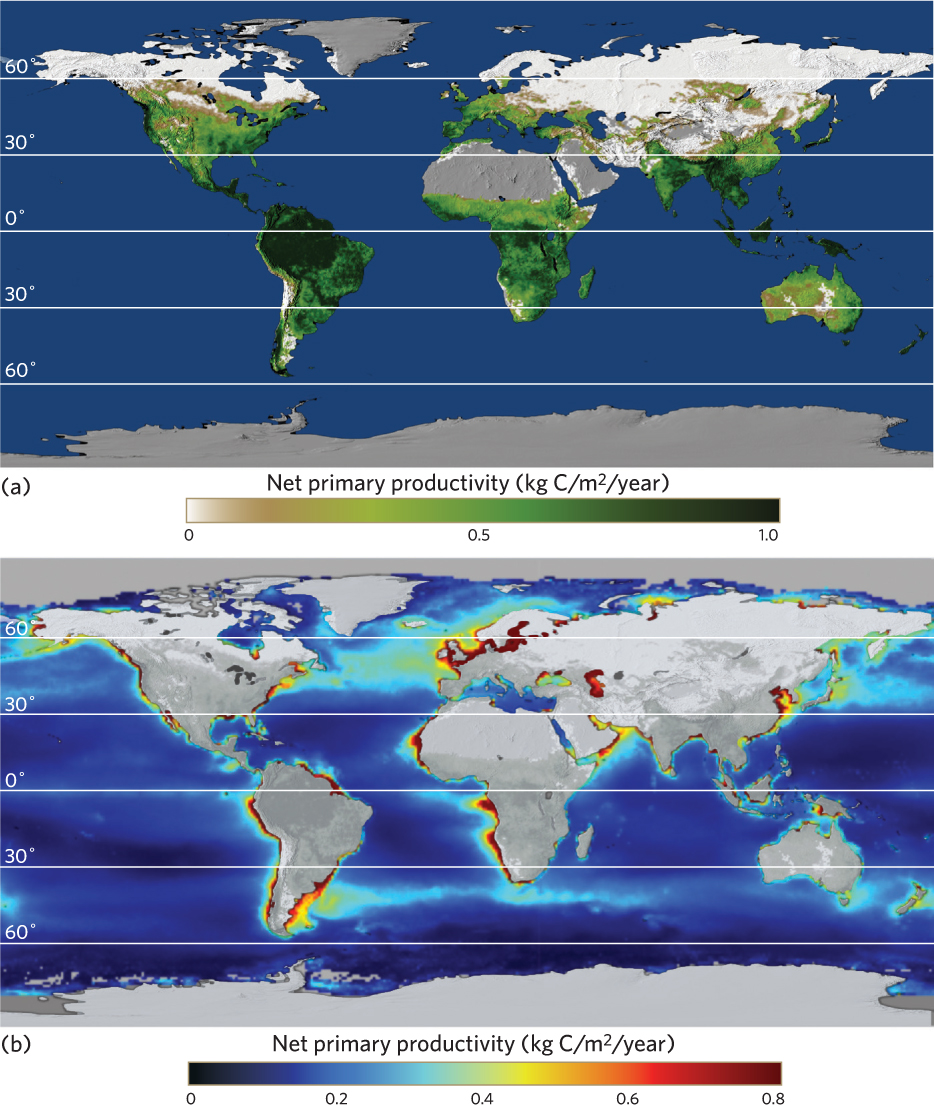
We can also consider the differences in NPP among different ecosystems that exist on the continents or in the oceans. These ecosystem categories largely coincide with the biomes described in Chapter 6. Figure 20.7 shows that tropical rainforests are the most productive terrestrial ecosystems. The least productive ecosystems include those that are very cold, such as tundra, and those that are very dry, such as deserts. Among the freshwater ecosystems, lakes and streams on average are on the low end of NPP, although NPP can vary widely in these systems. In contrast, marine ecosystems exhibit a wide range of productivity, ranging from high productivity in coral reefs and salt marshes to low productivity in the open ocean. Many abiotic factors are responsible for these patterns of productivity.
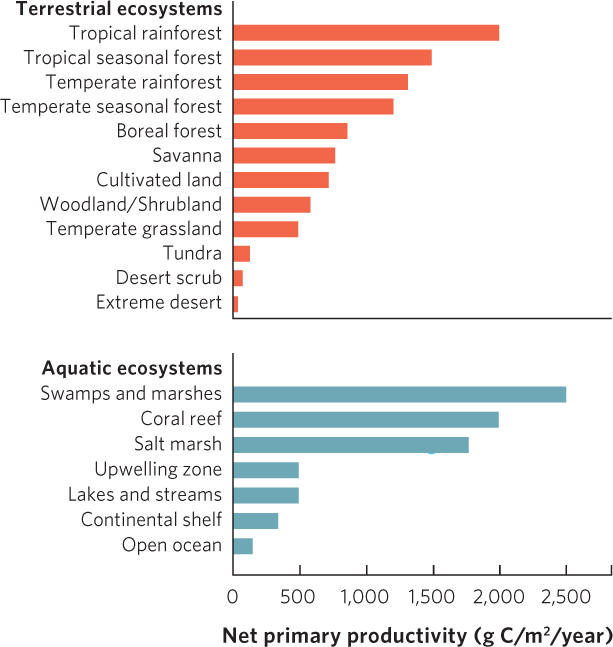
Drivers of Productivity in Terrestrial Ecosystems
As you may recall from our discussion of terrestrial biomes in Chapter 6, dominant plant forms are determined by patterns of annual temperature and precipitation. Similarly, temperature and precipitation are major drivers of NPP. The most productive terrestrial ecosystems occur in tropical areas because those areas have the most intense sunlight, warm temperatures throughout the year, high amounts of precipitation, and rapidly recycled nutrients that support growth. At higher latitudes, such as in temperate and polar regions, productivity is much lower due to shorter periods of sunlight and lower temperatures during the winter. In the deserts that occur at 30° N and 30° S latitude, productivity is primarily constrained by the lack of precipitation.
475
476
One way to examine the effects of temperature and precipitation on NPP is by looking at a large number of studies that have measured NPP in different parts of the world. For example, Figure 20.8 displays the results of studies from 96 locations. In Figure 20.8a, you can see that an increase in mean annual temperature is positively correlated with an increase in NPP. This reflects the fact that lower latitudes with warmer temperatures favor plant growth and have a longer growing season. In Figure 20.8b, you can see that an increase in mean annual precipitation shows a positive correlation with NPP until 3 m of annual precipitation is reached. Ecosystems that receive 3 m or more of precipitation experience a decline in NPP because nutrients leach away from the soil, and the rates of decomposition are reduced because of waterlogged soils. When organic matter is broken down more slowly, fewer nutrients are available in the soil for primary productivity. In short, while temperature and precipitation are the primary drivers of NPP in terrestrial ecosystems, they also influence the availability of nutrients in ways that affect NPP.
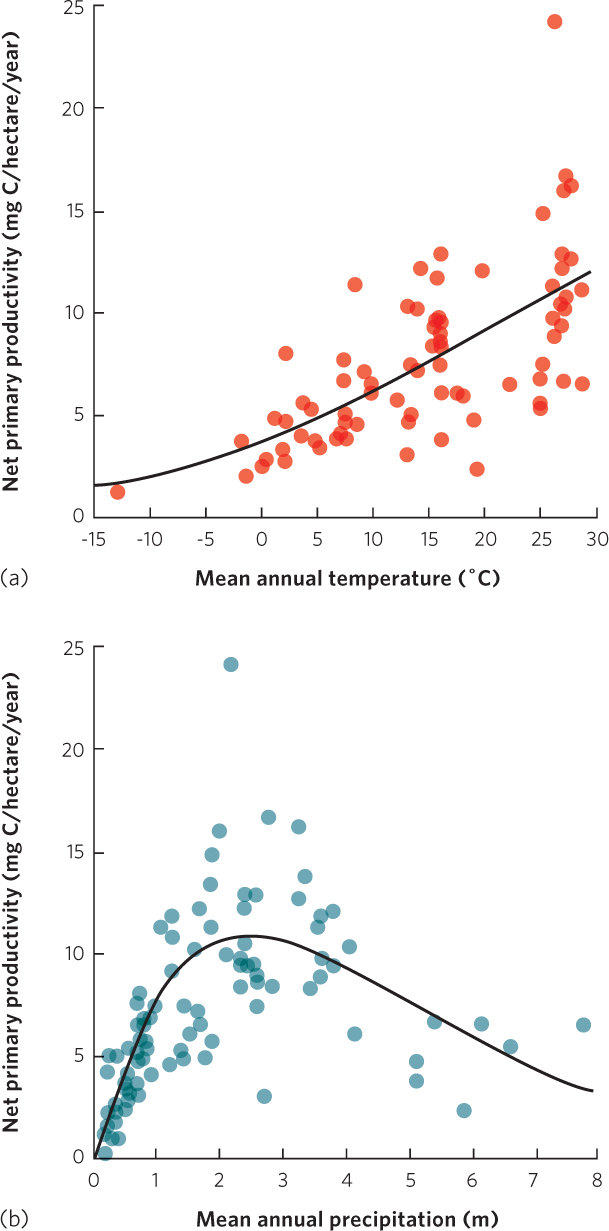
Given that nutrients affect NPP in terrestrial ecosystems, which nutrients are the most important? For decades, ecologists believed that nitrogen was the most important element that constrained NPP in terrestrial ecosystems. However, ecologists began to discover that some terrestrial ecosystems are also limited by phosphorus or a combination of nitrogen and phosphorus. To obtain a more accurate overview of whether nitrogen or phosphorus limited NPP, researchers in 2007 compiled data from 141 separate terrestrial experiments that had manipulated nitrogen, phosphorus, or both. For each experiment, they determined the ratio of NPP in treatments with added nutrients compared to NPP in the control, which had no added nutrients. With a response ratio for each study, the researchers could then determine the average response ratio for all studies in three categories of terrestrial ecosystems: grasslands, forests and shrublands, and tundra. As you can see in Figure 20.9, all three categories of terrestrial ecosystems experienced increases in NPP with the addition of nitrogen or phosphorus. In grasslands and tundra, adding both nitrogen and phosphorus caused a greater increase in NPP than either alone. From these data, we can see that nitrogen and phosphorus are both important nutrients that constrain NPP.
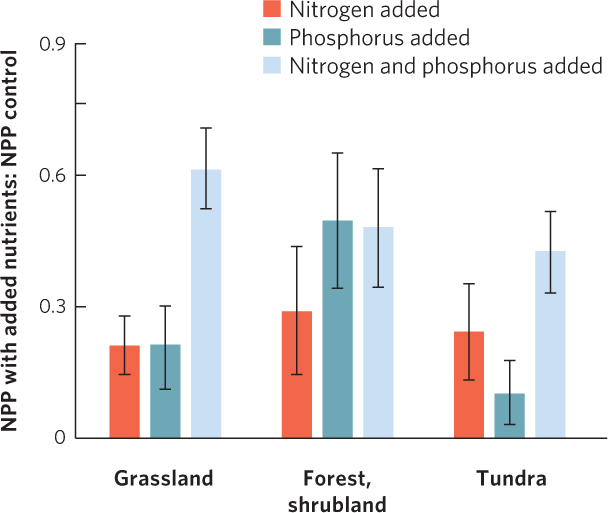
Drivers of Productivity in Aquatic Ecosystems
We have seen that terrestrial ecosystems are primarily constrained by temperature, precipitation, and nutrients. In addition to these factors, aquatic ecosystems are also constrained by light since the transmission of light down through the water is required for photosynthesis. Indeed, abundant light is one reason that coral reefs, which exist in shallow tropical waters, are such productive ecosystems. However, within aquatic ecosystems that have similar temperatures and similar light levels, the most important driver of NPP is the amount of nutrients.
The limiting role of nutrients can be seen in a variety of aquatic ecosystems. For example, in the open ocean, the remains of dead animals sink to the bottom where they decompose and release nutrients. Because this regeneration of nutrients is far below the ocean’s surface, the surface of the open ocean experiences low NPP. Small streams also are typically low in nutrients and experience low NPP. Moreover, if the small streams are in a forest, they receive little sun because of the shade from trees, and this restricts their productivity. As we discussed in Chapter 6, a large fraction of the energy and nutrients that exist in small streams enters the stream in the form of allochthonous inputs such as dead leaves that drop in from the surrounding terrestrial environment. In contrast, estuaries and coral reefs receive abundant nutrients in the form of runoff from rivers and the adjacent land, which allows these ecosystems to have very high primary productivity. Among all aquatic ecosystems, NPP is most commonly constrained by the availability of phosphorus and nitrogen, although silicon and iron can be limiting in some areas of the open ocean.
477
Limitation by Phosphorus and Nitrogen
For many years the conventional wisdom was that phosphorus is the most important nutrient that limits the NPP of aquatic ecosystems. For example, in a classic experiment David Schindler and his colleagues selected an hourglass-shaped lake in Ontario and placed a plastic curtain at the constriction that divided the lake into two halves (Figure 20.10a). On one side the researchers added carbon and nitrogen, and on the other side they added carbon, nitrogen, and phosphorus. These additions were continued from 1973 to 1980 as the researchers monitored the two sides of the lake, as well as a second lake that had an initial fertility similar to the divided lake to serve as a control. In the half of the lake that received carbon and nitrogen, there was a modest increase in NPP compared to the control lake, measured by the growth of cyanobacteria. However, in the half of the lake that received carbon, nitrogen, and phosphorus, there was a large increase in NPP, as shown in Figure 20.10b. After the treatments were terminated in 1980, the NPP of the side of the lake with added phosphorus rapidly declined. This experiment confirmed that human inputs of excess phosphorus—in the form of fertilizers that wash off farms and various household detergents—can have a major effect on the productivity of aquatic ecosystems.
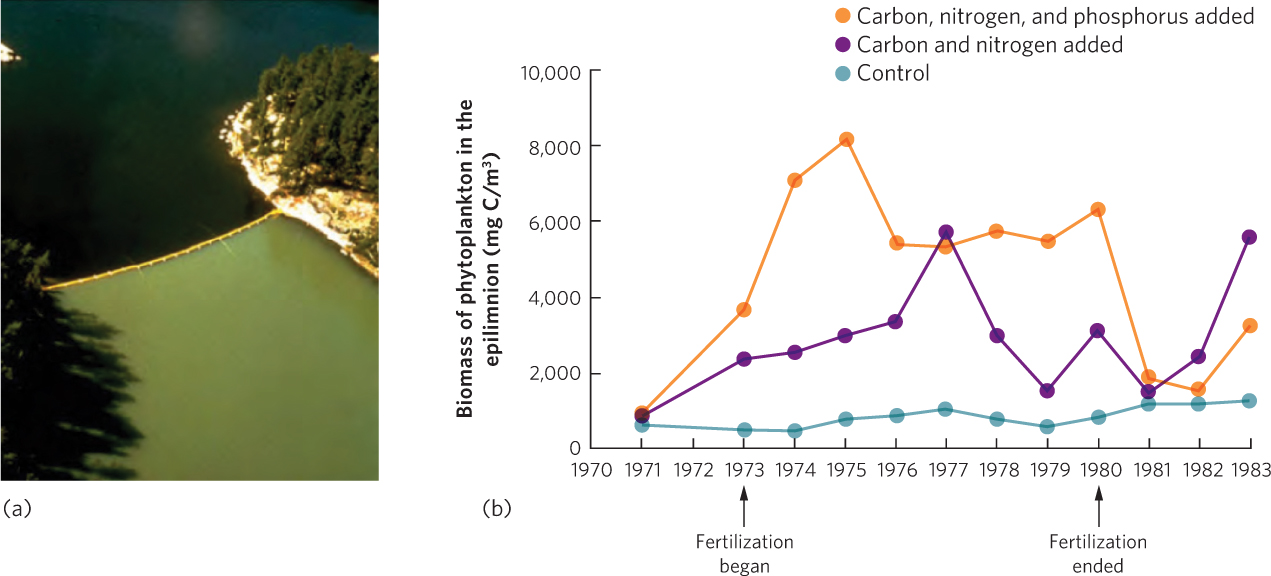
478
To gain a broader perspective on how nitrogen and phosphorus affect aquatic ecosystems, let’s revisit the average NPP responses from experiments conducted around the world. As part of the same 2007 study discussed earlier, researchers compiled data from 928 experiments that manipulated the addition of nitrogen, phosphorus, or both in freshwater and marine ecosystems. Among freshwater ecosystems, as shown in Figure 20.11a, nitrogen and phosphorus both caused an increase in NPP, although phosphorus has a much larger effect on the benthic ecosystem of lakes than does nitrogen. Among marine ecosystems, shown in Figure 20.11b, nitrogen and phosphorus additions had similar effects on NPP in ocean ecosystems with soft bottoms such as estuaries comprised of seagrass and algae. However, the addition of nitrogen had a much larger effect on NPP than that of phosphorus in ecosystems with hard bottoms, such as coral reefs and rocky intertidal biomes, and in the open water of oceans. Across all freshwater and marine ecosystems, adding nitrogen and phosphorus together often caused an NPP response that was much larger than adding either nutrient separately. The results of this research suggest that the availability of nitrogen and phosphorus can constrain the NPP of aquatic ecosystems, as well as that of terrestrial ecosystems.
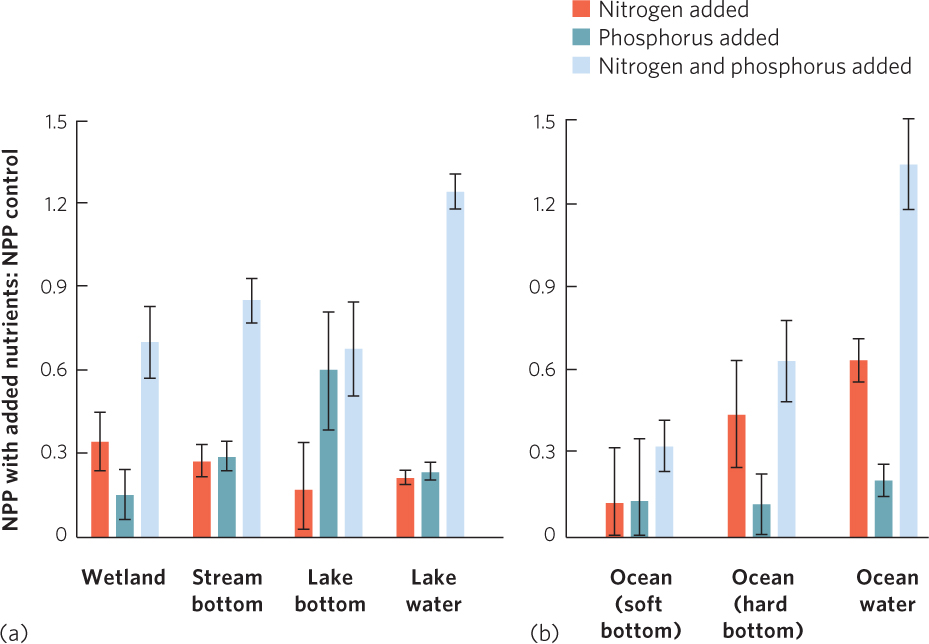
Limitation by Silicon and Iron in the Ocean
While the primary productivity of aquatic ecosystems is typically limited by the availability of nitrogen and phosphorus, primary productivity remains low in approximately 20 percent of the open ocean even though nitrogen and phosphorus are abundant there. This suggests that productivity in these areas is limited by other nutrients that are unusually scarce, such as silicon and iron.
479
Silicon is the raw material for the silicate shells of diatoms (see Figure 2.5), which comprise most of the phytoplankton in some regions of the ocean. Silicon is lost from the surface waters when diatoms die and their dense shells fall to the ocean bottom. For example, the area west of southern South America, between 40° S and 50° S latitude, appears to have too little silicon, probably because silicon containing particles sink below the photic zone more rapidly than do nitrogen and phosphorus across this long stretch of the southern Pacific Ocean.
Iron is an important component in many metabolic pathways, but it is lost from the ocean’s surface when it combines with phosphorus and precipitates. Rivers serve as a source of iron, which explains why low concentrations of iron appear to occur in regions of the ocean that are far from continents. In these areas, the only iron inputs occur in the form of windblown dust.
If iron limits the growth of phytoplankton in the ocean, then additions of iron should act as a fertilizer and cause large increases in primary productivity. In 1993, scientists conducted a large experiment in which they added 450 kg of iron—roughly the amount in an automobile—to over 64 km2 of ocean off the west coast of South America. The treatment caused a 100-fold increase in the concentration of iron and within just a few days the concentration of phytoplankton tripled. Although this increase in phytoplankton was of a short duration, the experiment confirmed that a lack of iron limited the producers in this area of the ocean. In subsequent experiments conducted off the coast of Antarctica, researchers observed similar increases in productivity (Figure 20.12).
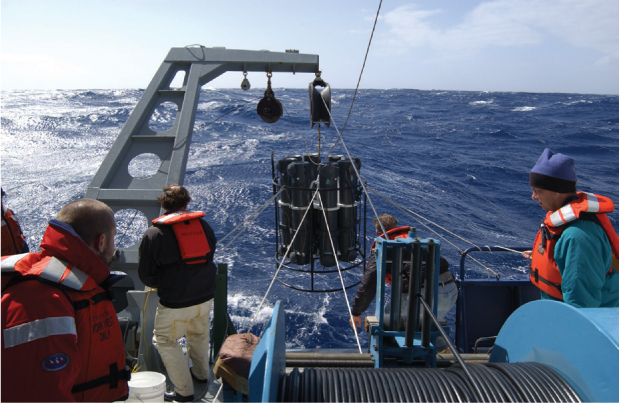
Fertilizing the ocean with iron has implications beyond confirming that iron is the limiting nutrient in these areas. If primary productivity in the ocean can be increased, it has the potential to draw down the amount of CO2 in the water. Because CO2 is exchanged between the water and the air, reducing CO2 in the water would subsequently reduce the amount of CO2 in the atmosphere. Since CO2 is a greenhouse gas, some scientists have hypothesized that fertilizing the oceans with iron could be a way to counteract global warming.
Although adding iron increased primary production, in some cases the large increase in phytoplankton caused a subsequent large increase in the zooplankton populations that consume phytoplankton. When this happened, the zooplankton that was produced caused an increase in the amount of CO2 due to increased respiration, thereby counteracting the beneficial effects of the phytoplankton. In 2004, researchers conducted experiments that monitored the amount of carbon that precipitated out of the water column during iron additions and found that there was a small increase in the amount of exported carbon. Despite these somewhat promising results, the long-term effects of iron enrichment on CO2 remain uncertain, as does the question of whether large-scale applications of iron in the ocean could have potential adverse effects on the ocean ecosystem.